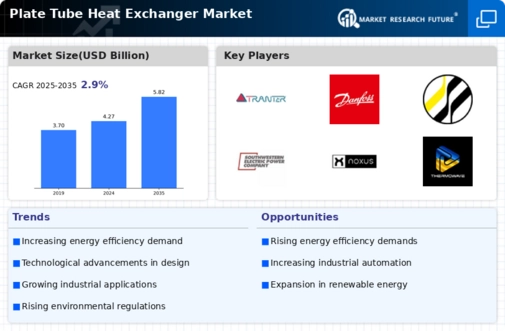Plate Tube Heat Exchanger Market Summary
The Global Plate Tube Heat Exchanger Market is projected to grow from 4.27 USD Billion in 2024 to 5.83 USD Billion by 2035.
Key Market Trends & Highlights
Plate Tube Heat Exchanger Key Trends and Highlights
- The market is expected to experience a compound annual growth rate (CAGR) of 2.86% from 2025 to 2035.
- By 2035, the market valuation is anticipated to reach 5.82 USD Billion, indicating steady growth.
- in 2024, the market is valued at 4.27 USD Billion, reflecting its current size and potential for expansion.
- Growing adoption of energy-efficient technologies due to increasing environmental regulations is a major market driver.
Market Size & Forecast
| 2024 Market Size | 4.27 (USD Billion) |
| 2035 Market Size | 5.83 (USD Billion) |
| CAGR (2025-2035) | 2.87% |
Major Players
Alfa Laval, Tranter, Danfoss, Kelvion, API Heat Transfer, SWEP, GEA Group, NOXUS, Senex Thermal Products, Wuhan Boiler Group, Thermowave, HRS Heat Exchangers, Funke Wärmeaustauscher, Thermal Innovations, Hisaka Works




















